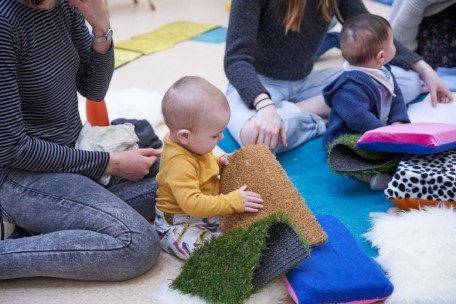The end of term has arrived, and we’ve reached the end of the 20th Medieval and Renaissance Year Course. I’ve enjoyed writing the ‘Twenty Objects’ blog, and will be back with occasional posts in the autumn. Meanwhile the last of our ‘Twenty Objects for Twenty Years’ is written by a former student, Dr Samantha Darell (2003 – 4), who recently gained her PhD from the Courtauld Institute of Art – which shows what can happen when you embark on a V&A Year Course! Sam’s thesis is entitled ‘Late Medieval Mother-of-Pearl Carvings; Making and Meaning, An examination of a material in context from the late Fourteenth to the late Fifteenth Century in France, England and Italy’ and breaks new ground in a much-neglected area that is, appropriately, well represented in the V&A’s collection.

Female Saint, Germany, Carved mother of Pearl in a Silver Mount, Medieval and Renaissance Galleries, Room 62, Case 8, Mus Ref: A.72-1929 © Victoria and Albert Museum, London
The Victoria and Albert Museum has one of the largest collections of mother-of-pearl carvings in the world. The size of the original shell determines the dimensions of the piece and what it is possible to carve from it, so mother-of-pearl carvings are no more than 8 or 9 cm in diameter. Walk past this small carving of the Virgin and you might barely notice it. This is the fate of most pieces as it was a valued material in the fifteenth century that was often combined with gold, gilded silver and precious gems. It is also a material which is soft and large enough to be carved with figurative reliefs. When gold works of the fifteenth century were destroyed, as most of them were, their precious metals were melted down and their gemstones re-used. However, mother-of-pearl carvings often survive and retain their original form. They therefore remain an important source of evidence for objects that have been long lost to us.
Hidden away in a side room of the medieval collections, this carving is currently enclosed in metal and equipped with a hanging device. This encourages the viewer to think of the carving as a pendant. The style of the engraving of Saint John the Evangelist on the back suggests that this metal enclosure dates from the sixteenth century. St John was a particularly suitable saint to pair with the Virgin, as according to the Golden Legend (a medieval book of saints), John was both associated with virginal chastity and entrusted with the care of the Virgin after Christ’s death. However, at the base of the carving is a small, drilled hole, which suggests that it was not always set as a pendant. A number of surviving examples show us that mother-of-pearl figures such as this were attached to a metal background by drilling holes in them and affixing them to the surface with a nail through the bottom.

St John the Evangelist, Rear , Germany, Carved mother of Pearl in a Silver Mount, Medieval and Renaissance Galleries, Room 62, Case 8, Mus Ref: A.72-1929 © Victoria and Albert Museum, London
The carving shows a female with bowed head and folded arms, appropriate for a Virgin of the Annunciation, although it is also possible that the carving represents another female saint. Mother-of-pearl was a particularly appropriate material for the representation of the Virgin as pearls were associated with purity and virginity. Moreover, an ancient Indian myth, known in the West through Pliny’s Natural History, suggested that the pearl was formed in an unusual way. The pearl shell was thought to rise to the surface of the ocean and open. A drop of dew would then fall from Heaven into the shell, which would sink back down into the water. The shell was thus “impregnated” and a pearl would form inside. The shell therefore became known as mother-of-pearl. Since Christ was often thought of as the “pearl of great price” (Matthew 13:46) and the pearl was thought to have been conceived without intercourse, the pearl shell thus became the vehicle for an “immaculate conception”. In fact, the idea that the pearl shell produced a pearl child without sexual intercourse was later used as proof that the Immaculate Conception could have taken place.
I completed the Medieval and Early Renaissance Course at the V&A under Dr Sally Dormer and Dr Paula Nuttall. Although I had taken a number of art history courses before, participating in the course completely changed the way I thought about art. It took me from reading about what other people thought about art works, to examining them and coming to my own conclusions. When I began, I was always interested to know what the experts knew and would turn immediately to a catalogue to find out information. One of the first exercises we did on the course was to choose an object in the museum and write about what we could observe. This exercise in close looking was a valuable experience and provided the foundation for skills which I have been developing ever since. I also enjoyed the handling sessions and the geographical range of the course. The latter introduced me to Netherlandish art, which I had hardly considered before and which I found very beautiful. At the end of the year I didn’t want the course to end and Paula and Sally suggested I apply to the Courtauld Institute of Art. I completed my Postgraduate Diploma there, followed by my Master’s Degree and have just finished my PhD. The Medieval and Early Renaissance Course really did change my life and I will forever be grateful to the tutors, not only for the skills they taught me, but also for inspiring a love for this period.
“Twenty Objects for Twenty Years” is a series of articles written by Dr Paula Nuttall, Director of the Late Medieval to Early Renaissance Year Course, exploring some of her favourite pieces in the V&A’s extensive Renaissance collections along with contributions from students and museum staff. You can find the rest of the series along with other posts from the Learning Department at the V&A on their blog.


